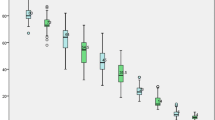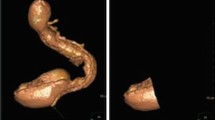Abstract
Introduction
Laparoscopic sleeve gastrectomy is one of the most common techniques in bariatric surgery, but there is no consensus on the optimal distance from the pylorus to start the gastric transection. The aim of this study is to determine the differences in gastric emptying, gastric distension and metabolic response between two starting distances.
Material and Methods
This is a prospective randomised study of 60 patients (30 patients with the section at 3 cm and 30 patients at 8 cm from the pylorus). We calculate at 6 and 12 months from surgery gastric emptying by scintigraphy (T1/2 min), gastric volume by CT scan (cc) and metabolic response by blood sample analysis (glucose, HbA1c, insulin, HOMA-IR, GLP-1, GIP and C-peptide).
Results
Gastric emptying increases the speed significantly in both groups but is greater in the 3-cm group (p < 0.05). Dividing groups into type 2 diabetic patients and non-diabetic patients, the speed in non-diabetic patients is significantly higher for the 3-cm group. Residual volume increases significantly in both groups, and there are no differences between them. One year after surgery, there are significant improvements in the hyperinsulinaemia in the patients of the 3-cm group with respect to the 8-cm group, but only in diabetic patients. No differences between groups are found regarding changes in GLP-1 or GIP.
Conclusions
Gastric emptying is faster in patients with antrum resection. The distance does not influence the gastric emptying of diabetic patients. Other mechanisms may explain metabolic response besides GLP-1 and its association with improvements in diabetes via gastric emptying.





Similar content being viewed by others
References
Rodríguez-Rodríguez E, López-Plaza B, López-Sobaler AM, et al. Overweight and obesity among Spanish adults. Nutr Hosp. 2011;26(2):355–63.
Sánchez-Santos R, Sabench Pereferrer F, Estévez Fernandez S, et al. Is the morbid obesity surgery profitable in times of crisis? A cost-benefit analysis of bariatric surgery. Cir Esp. 2013;91(8):476–84.
Milone L, Strong V, Gagner M. Laparoscopic sleeve gastrectomy is superior to endoscopic intragastric balloon as a first stage procedure for super-obese patients (BMI > or =50). Obes Surg. 2005;15(5):612–7.
Gagner M, Deitel M, Erickson AL, et al. Survey on laparoscopic sleeve gastrectomy (LSG) at the Fourth International Consensus Summit on Sleeve Gastrectomy. Obes Surg. 2013;23(12):2013–7.
Braghetto I, Davanzo C, Korn O, et al. Scintigraphic evaluation of gastric emptying in obese patients submitted to sleeve gastrectomy compared to normal subjects. Obes Surg. 2009;19:1515–21.
Segura Molina E, Chover González AJ, Partida Palma F, et al. Analysis of gastric emptying dynamics in relationship to qualitative composition of intake. Comparison between normal-weight and obese subjects. Rev Esp Med Nucl. 2006;25(3):172–9.
Weiner RA, Weiner S, Pomhoff I, et al. Laparoscopic sleeve gastrectomy—influence of sleeve size and resected gastric volume. Obes Surg. 2007;17:1297–305.
Melissas J, Daskalakis M, Koukouraki S, et al. Sleeve gastrectomy-a “food limiting” operation. Obes Surg. 2008;18(10):1251–6.
Deane AM, Nguyen NQ, Stevens JE, et al. Endogenous glucagon-like peptide-1 slows gastric emptying in healthy subjects, attenuating postprandial glycemia. J Clin Endocrinol Metab. 2009;95:215–21.
Peterli R, Wölnerhanssen B, Peters T, et al. Improvement in glucose metabolism after bariatric surgery: comparison of laparoscopic Roux-en-Y gastric bypass and laparoscopic sleeve gastrectomy: a prospective randomized trial. Ann Surg. 2009;250(2):234–41.
Shah S, Shah P, Todkar J, et al. Prospective controlled study of effect of laparoscopic sleeve gastrectomy on small bowel transit time and gastric emptying half-time in morbidly obese patients with type 2 diabetes mellitus. Surg Obes Relat Dis. 2010;6(2):152–7.
Gagner M. Faster gastric emptying after laparoscopic sleeve gastrectomy. Obes Surg. 2010;20(7):964–5.
Chambers AP, Smith EP, Begg DP, et al. Regulation of gastric emptying rate and its role in nutrient-induced GLP-1 secretion in rats after vertical sleeve gastrectomy. Am J Physiol Endocrinol Metab. 2014;306(4):E424–32.
Brethauer SA, Kim J, El Chaar M, et al., ASMBS Clinical Issues Committee. Standardized outcomes reporting in metabolic and bariatric surgery. Obes Surg. 2015;25(4):587–606. doi:10.1007/s11695-015-1645-3.
Sabench Pereferrer F, Molina López A, Vives Espelta M, et al. Weight loss analysis according to different formulas after sleeve gastrectomy with or without antral preservation: a randomised study. Obes Surg. 2016;27(5):1254–60. doi:10.1007/s11695-016-2454-z.
Kueper MA, Kramer KM, Kirschniak A, et al. Laparoscopic sleeve gastrectomy: standardized technique of a potential stand-alone bariatric procedure in morbidly obese patients. World J Surg. 2008;32(7):1462–5.
Parikh M, Gagner M, Heacock L, et al. Laparoscopic sleeve gastrectomy: does bougie size affect mean %EWL? Short-term outcomes. Surg Obes Relat Dis. 2008;4(4):528–33.
Michalsky D, Dvorak P, Belacek J, et al. Radical resection of the pyloric antrum and its effect on gastric emptying after sleeve gastrectomy. Obes Surg. 2013;23(4):567–73.
Farrell MB, Costello M, McKee JD, et al. Compliance with gastric-emptying scintigraphy guidelines: a report from the Intersocietal Accreditation Commission database. J Nucl Med Technol. 2017;45(1):6–13.
Bernstine H, Tzioni-Yehoshua R, Groshar D, et al. Gastric emptying is not affected by sleeve gastrectomy—scintigraphic evaluation of gastric emptying after sleeve gastrectomy without removal of the gastric antrum. Obes Surg. 2009;19(3):293–8.
Sista F, Abruzzese V, Clementi M, et al. The effect of sleeve gastrectomy on GLP-1 secretion and gastric emptying: a prospective study. Surg Obes Relat Dis. 2017;13(1):7–14. doi:10.1016/j.soard.2016.08.004.
Vidal P, Ramón JM, Busto M, et al. Residual gastric volume estimated with a new radiological volumetric model: relationship with weight loss after laparoscopic sleeve gastrectomy. Obes Surg. 2014;24(3):359–63.
Braghetto I, Cortes C, Herquiñigo D, et al. Evaluation of the radiological gastric capacity and evolution of the BMI 2-3 years after sleeve gastrectomy. Obes Surg. 2009;19(9):1262–9.
Obeidat F, Shanti H, Mismar A, et al. The magnitude of antral resection in laparoscopic sleeve gastrectomy and its relationship to excess weight loss. Obes Surg. 2015;25(10):1928–32.
Yan W, Bai R, Yan M, et al. Preoperative fasting plasma C-peptide levels as predictors of remission of type 2 diabetes mellitus after bariatric surgery: a systematic review and meta-analysis. J Investig Surg. 2017; doi:10.1080/08941939.2016.1259375.
Lee WJ, Chong K, Chen SC, et al. Preoperative prediction of type 2 diabetes remission after gastric bypass surgery: a comparison of DiaRem scores and ABCD scores. Obes Surg. 2016;26(10):2418–24.
Acknowledgements
This study was funded by the “Carlos III Research Institute”/Ministry of Economy and Competitiveness (registration number PI 11/02332), Spain. We are very grateful for the tasks of the nursing teams of the operating rooms and hospitalisation area, whose help has been indispensable for the correct functioning of the project, as well as all the staff of the Anesthesiology and Rehabilitation Service.
Author information
Authors and Affiliations
Corresponding authors
Ethics declarations
Informed consent was obtained from all individual participants included in the study. All procedures performed were in accordance with the ethical standards of the institutional research committee (registration number CEIC11–04-28/4PROJ3) and with the 1964 Helsinki declaration and its later amendments.
Conflict of Interest
The authors declare that they have no conflict of interest.
Rights and permissions
About this article
Cite this article
Vives, M., Molina, A., Danús, M. et al. Analysis of Gastric Physiology After Laparoscopic Sleeve Gastrectomy (LSG) With or Without Antral Preservation in Relation to Metabolic Response: a Randomised Study. OBES SURG 27, 2836–2844 (2017). https://doi.org/10.1007/s11695-017-2700-z
Published:
Issue Date:
DOI: https://doi.org/10.1007/s11695-017-2700-z




